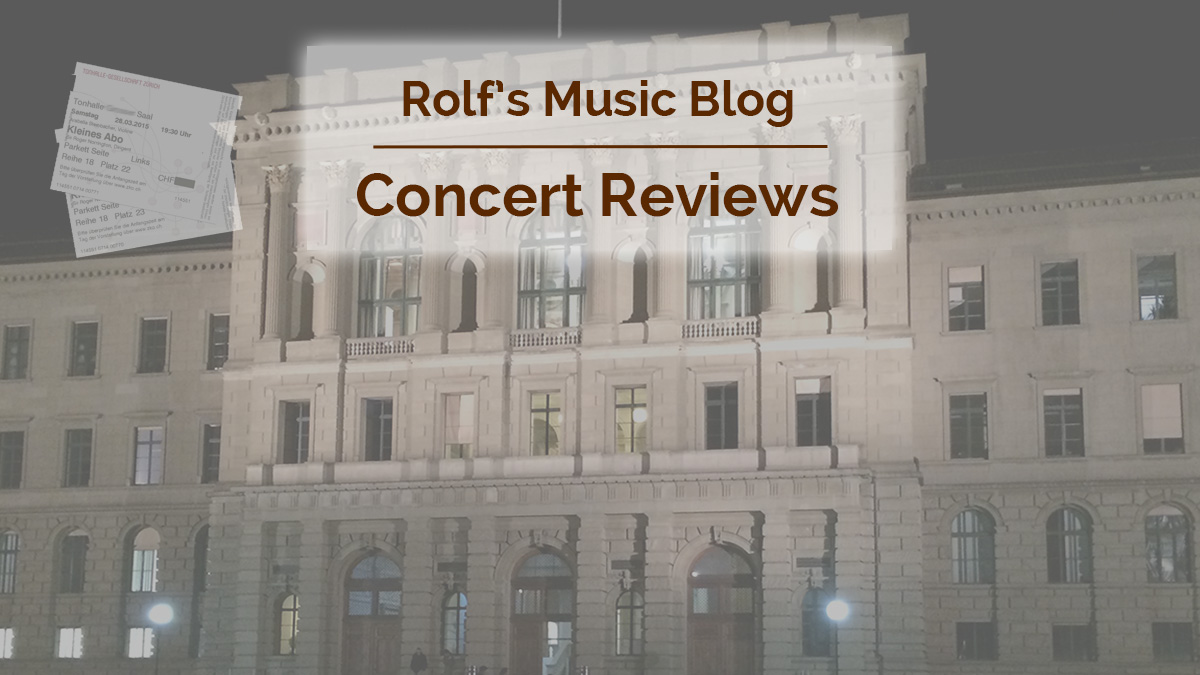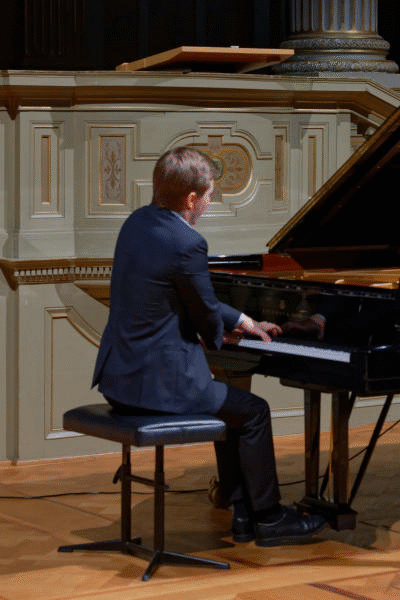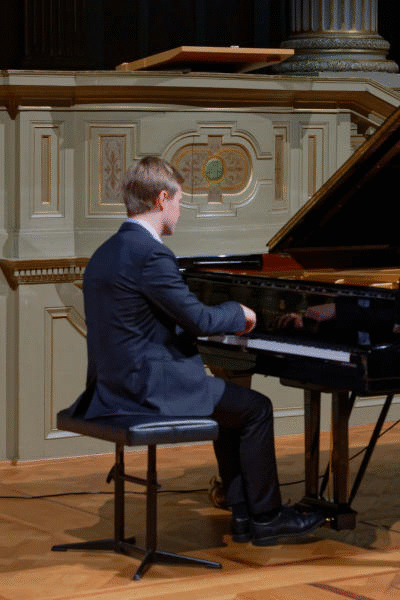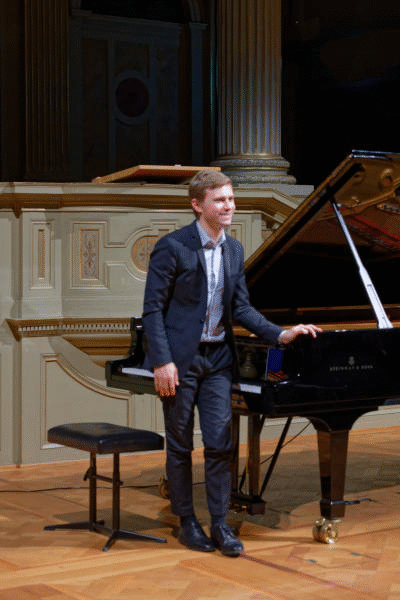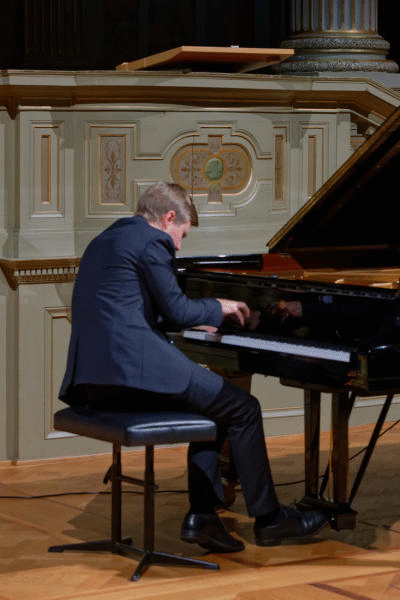Piano Recital: Dmytro Choni
Brahms / Schumann / Liszt / Rachmaninoff
Semper-Aula, ETH Zurich, 2019-11-19

2019-11-26 — Original posting

Ein viel versprechendes Talent aus der Ukraine in einem äußerst eindrücklichen Solo-Recital an der ETH — Zusammenfassung
Der Ukrainer Dmytro Choni (*1993) begeisterte von Anbeginn weg. Sehr eindrücklich bereits die zwei Rhapsodien op.79 von Johannes Brahms. Es folgten die “Gesänge der Frühe”, op.133 von Robert Schumann. Hier tauchte Dmytro Choni in die berührend-meditative Stimmung von Schumann’s spätesten Kompositionen ein, die in vielem an die “Geister-Variationen” erinnern. Danach kehrte der Pianist zur Virtuosität zurück, mit einer fulminanten, beeindruckend geschlossenen und überzeugenden Darbietung der Dante-Sonate (die Nr.7 aus den “Années de Pèlerinage, 2me Année – Italie“) von Franz Liszt.
Folgte die erste Konzerthälfte dem Schema “virtuos — meditativ — virtuos”, so begann Dmytro Choni nach der Pause mit den zwei lyrischen Lied-Transkriptionen “Daisies” (op.38/3) und “Lilacs” (op.21/5) von Sergey Rachmaninoff, und er blieb bei diesem Komponisten: die Nr.4, ein Presto in e-moll aus den Moments Musicaux, op.16 ist bereits voll von typisch Rachmaninoffscher Virtuosität—erst recht danach die hochvirtuose Sonate Nr.2 in b-moll, op.36.
Als ob dies der Virtuosität nicht genug gewesen wäre, bot Dmytro Choni als erste Zugabe Soirée de Vienne, op.56 des weitgehend vergessenen Österreichischen Pianisten und Komponisten Alfred Grünfeld. Es ist dies eine effektvolle “Konzertparaphrase über Johann Strauß’sche Walzermotive aus Fledermaus u.a.”: leichte Muse, und dennoch ein brillanter “Rausschmeißer”. Den Abschluss machte schließlich die erste der zwei Arabesken (L.66) von Claude Debussy—und Choni zeigte sich auch in der Atmosphäre des französischen Impressionismus stilsicher und überzeugend. Ein sehr bemerkenswertes Rezital!
Table of Contents
- Introduction
- The Artist
- Program
- Concert & Review
- Brahms: 2 Rhapsodies, op.79
- Schumann: Gesänge der Frühe , op.133
- Liszt: “Dante Sonata” , S.161/7
- Rachmaninoff: 6 Romances, op.38: No.3, “Daisies”
- Rachmaninoff: 12 Romances, op.21: No.5, “Lilacs”
- Rachmaninoff: Moments Musicaux , op.16 — No.4, Presto in E minor
- Rachmaninoff: Piano Sonata No.2 in B♭ minor, op.36
- Encore 1 — Grünfeld: Soirée de Vienne , op.56
- Encore 2 — Debussy: Deux Arabesques , L.66 – 1. Andantino con moto
Introduction
About the Concert
With this concert review, I start using a shorter introduction. The latter is often boring the reader with introductory text that is mostly unspecific phraseology and/or quoted/derived from third party sources (Web sites, concert booklet, etc.). I now use a simpler, more schematic approach: clearly structured, yet containing the relevant information. The latter is typically not quoted / fully spelled out, but offered as links to third party sources. With this, there is less text, but the information provided is unfiltered, typically more comprehensive and accurate.
On a short side-note: I’m only breaking down the “star rating” to pieces and movements where I see differentiation, i.e., I try to avoid “sprinkling star ratings everywhere” (as I may have done in the past). There may be a single rating per composition, occasionally even a single one for an entire recital or concert.
Venue, Location
Semper-Aula (99 seats), a historic (though partially unfinished) hall in the main building of the ETH (Swiss Federal Institute of Technology) in Zurich.
Organizer, Related Information
The concert was organized by Musical Discovery, an agency that is located in Zurich. Musical discovery is an artists’ agency that also offers this concert series, as well as Summer Courses for pianists. See their Website for details.
Series, Context, etc.
This concert was part of the series Musik an ETH und UZH (featuring concerts in the above venue, in the Auditorium maximum in the same building, as well as in the Auditorium maximum at the University. In addition, in this season, Musical Discovery also organizes a series of piano recitals in the small Aula of the Alte Kantonsschule (“old high school”, now also part of the university), featuring all of Beethoven’s piano sonatas.
Setting, etc.
I was offered the left-most seat in row #3 of the well-filled hall. This proved ideal for taking photos without disrupting others too much. I actually wanted to be even less disruptive this time, so I placed my camera on a tripod at a window to the left, and I operated it using a remote control unit, but still using silent shooting (live view mode). That latter option has limited focusing options, and this time I did not have the possibility to select focus points manually, as the pianist was moving around, So, I pre-set the focus—and unfortunately mis-set it. I apologize for the pianist being out of focus in all shots. In order to make the focus blurring less obvious, I have reduced the size of the pictures, and I grouped most of them into animated GIFs.
The Artist
The Ukrainian pianist Dmytro Choni was born 1993, in Kyiv (Kiev). After winning highly ranked international competitions, the artist has successfully launched a career as concert pianist, with appearances in prominent concert halls, and at notable festivals. For detail see the artist’s biography.
Program
Dmytro Choni put his recital under the title “Romantic Songs and Tales“:
- Johannes Brahms (1833 – 1897): 2 Rhapsodies, op.79
- Robert Schumann (1810 – 1856): Gesänge der Frühe, op.133
- Franz Liszt (1811 – 1886): “Années de Pèlerinage, 2me Année – Italie” — No.7, Après une lecture du Dante, S.161/7
(Intermission) - Sergei Rachmaninoff (1873 – 1943):
The “Songs and Tales” aspect in the title of the concert primarily applies to the op.133 by Schumann, and to the two song transcriptions by Rachmaninoff. However, some of the other works in the recital (Brahms, Rachmaninoff) also have strong melodic aspects, besides being highly virtuosic and technically challenging.
Concert & Review
Brahms: 2 Rhapsodies, op.79
Johannes Brahms (1833 – 1897) wrote the 2 Rhapsodies, op.79 in 1879:
- Rhapsody in B minor: Agitato
- Rhapsody in G minor: Molto passionato, ma non troppo allegro
The Performance
Dmytro Choni’s appearance was modest, friendly, smiling, natural, inconspicuous. From his looks, very little, if anything, would have made one guess the powerful artist at the piano that we were going to experience. Only his hands / fingers seemed slightly bigger & stronger than expected from the rest of his physiology, let alone the boyish physiognomy. On the other hand, the absence of signs of nervousness or stage anxiety gave testimony of his experience with concerts and competitions. Quite obviously, he does not see a need to show off with spectacular gestures, nor to cover up: a “blank sheet of paper” to those (like myself) who have never had watched him play.
While playing, Dmytro Choni stayed focused on the instrument. I could at best see his profile, as he rarely, if ever, looked into the audience. During the performance, one could observe the emphasis in his playing from the lively movements in his entire body (the animated GIFs give a good impression of this). On the other hand, he seemed to keep his facial expression under control, i.e., I did not observe excessive (inadvertent) grimacing. A joy to watch!
I. Rhapsody in B minor: Agitato
Emotionally, by starting with the two Brahms Rhapsodies, Dmytro Choni “threw himself in medias res“. The articulation was sharp—most notable when he was jumping to chords and octaves in the descant. And it was clear and clean, despite the full sonority of the Steinway D-274. The pianist played with lots of emphasis in his body movements / language. The tempo was fairly fresh (Brahms did not specify metronome numbers), and in terms of agogics, Dmytro Choni avoided excessive dilatations of individual bars and motifs, rather was spanning a single phrasing arch over the first theme (15 bars). Only in the transition and in the lyrical second theme, the artist took back the tempo, now using distinct agogics to add expression to motifs and short cantilenas. It was instantly clear: a pianist with astounding technical abilities, power and control!
At the end of the first (B minor) part, Dmytro Choni made an almost extreme (but perfectly adequate) ritardando, added a long fermata. Then, we found ourselves in the middle part in B major: very lyrical, with beautiful cantilenas, warm and intense in the expression. I now noted the highly differentiated dynamics, in particular the subtle dynamic balance between the two voices in the right hand. Occasionally Choni used subtle arpeggiando to soften the articulation, and to maintain transparency.
The second B minor part brought a return to the “big, rhapsodic” playing. Though, again with the contrasting, lyrical F major segment in the center. Was it the impression from the B major section that made this now sound more mellow, mild, lyrical? Dmytro Choni maintained the full tension and intensity through the long ritardando and decrescendo, up to the gentle pp ending. An excellent opening!
II. Rhapsody in G minor: Molto passionato, ma non troppo allegro
Grand, rhapsodic tone, well-rounded sonority, consistent dynamic build-ups, controlled, excellent (“speaking”) agogics, and a “big breath” for long build-ups and phrases: a performance with emotional depth and intensity (though devoid of exaggerations)!
Rating: ★★★★½
Schumann: Gesänge der Frühe, op.133
Robert Schumann (1810 – 1856) wrote the Gesänge der Frühe (Songs of Dawn), op.133 in 1853, devoting them to the “High Poetess Bettina”. This obviously meant Bettina von Arnim (born Brentano, 1785 – 1859). This is one of Schumann’s last compositions and features five movements:
- Im ruhigen Tempo (In a tranquil tempo)
- Belebt, nicht zu rasch (Animated, not too quick)
- Lebhaft (Lively)
- Bewegt (With motion)
- Im Anfange ruhiges, im Verlauf bewegtes Tempo (initially tranquil, later moving tempo)
The Performance
A considerate artist! After the applause, Dmytro Choni typically laid his arms / hands on his lap, closing his eyes, resting quietly for almost a minute, mentally preparing himself for the next composer / piece, and waiting for the atmosphere to settle, for the “right moment” to start again. And here, indeed, the atmosphere was so radically different:
I. Im ruhigen Tempo
At an instant, the audience found itself in the broken “autumn atmosphere” of the very late Schumann, retained, pensive, meditating, momentarily breaking out in intense, lucid, serene memories, strongly resembling the mood of the “ghost variations”. It was so immensely touching to experience the composer’s fading genius, his melancholy and despair. One could almost feel that he must have been in tears writing this down!
II. Belebt, nicht zu rasch
Mere memories of joy, of virtuosity and rhapsodic playing? In their briefness, these pieces must feel like fragmentary snippets. Nevertheless, Dmytro Choni presented them as valuable, little gems—and still great music in its own, specific way!
III. Lebhaft
Here, the composer appears to have found back to the powers of the peak of his career: big, even grandiose gestures despite the compact format. And yet, the music retains a folk tone, the catchy harmonies so typical of Schumann. Technically, this piece is not trivial. Dmytro Choni’s performance, though, was really masterful.
IV. Bewegt
Also here, Choni’s playing was truly excellent, making the score sound easy. He remained fluent in the constant cascades of the falling demisemiquaver arpeggios, while making the melody in the top voice sing throughout the piece: technicalities don’t seem to exist for this artist!
V. Im Anfange ruhiges, im Verlauf bewegtes Tempo
Not surprisingly, the composer fell back into the “ghost mood” of the first piece. After the pensive, melancholic beginning, there is again a touching melody. Schumann almost buries it in one or two constant semiquaver movements, though Dmytro Choni still makes it sing, makes it fight its way through the “noisy” accompaniment. The final decrescendo retracts into silence. I sensed both peace and melancholy, beautiful memories and tears about the passing of joy and beauty: so intense, so emotional!
Rating: ★★★★½
Liszt: “Dante Sonata”, S.161/7
In his “Années de Pèlerinage”, 2me Année – Italie by Franz Liszt (1811 – 1886) from 1830, the No.7 has the title Après une lecture du Dante, Fantasia quasi Sonata, S.161/7. It is also known as “Dante Sonata” and features numerous tempo annotations:
- Andante maestoso — Più moto — Presto agitato assai — Tempo I (Andante) — Andante quasi improvisato — (lunga pausa)
- Andante — Recitativo — Adagio — Allegro moderato —
- Più mosso — Tempo rubato e molto ritenuto — Andante — Più mosso — Allegro — Allegro vivace — Presto — Andante
For more of a description and a reference to an earlier concert experience and report see the review of a concert in Zurich, on 2019-04-30.
The Performance
Andante maestoso — Più moto — Presto agitato assai — Tempo I (Andante) —
Indeed maestoso and also pesante—yet controlled in the energy, avoiding slow-down as well as inappropriate acceleration in these fanfares, where the composer left the listener without a defined rhythm, seemingly without a meter. With the Più moto, the music momentarily picked up momentum. However, Dmytro Choni maintained control and tension, didn’t unleash his powers.
Even at the Presto agitato assai, the music initially remains restrained (note: Liszt writes lamentoso, later diminuendo and sempre legato). However, very soon, the emotions start boiling up! Choni’s playing is impressive both in volume and sonority, as well as in how truthful he remained to Liszt’s dynamics, while forming astounding dynamic arches. Technically really masterful, building up to a breathtaking climax. The music abruptly returns to the initial fanfare, the pesante chords for a short moment.
Andante quasi improvisato —
Then, in a surprise move, the atmosphere momentarily changes into the dreamy mood (ppp) of a free-flowing improvisation, seemingly aimless, seeking…
Andante — Recitativo — Adagio — Allegro moderato —
That doesn’t last long, though. After a fermata, Liszt starts an extended, beautiful and expressive cantilena in the right hand, which also must master the accompanying quaver triplets. Choni again formed harmonious dynamic arches, while keeping the lyrical melody singing. Rubato made the melody “breathe”. A short recitative followed, hesitations, swaying emotions, a build-up to another impressive climax. This wasn’t, though, as the music further accelerated…
Più mosso — Tempo rubato e molto ritenuto —
and again, the listener remained stunned, breathless during the highly virtuosic climax, seemingly endless, until only the transition to the Tempo rubato e molto ritenuto offered a little relief. Though, composer and artist never dropped the tension even in the latter section, which appeared to seek again, pondering, ending in mysterious pauses and a fermata, full of suspense!
Andante — Più mosso — Allegro — Allegro vivace — Presto — Andante
With the power and volume that the pianist showed in the virtuosic climaxes, the dynamic balance and control in the subtle, serene Andante was all the more amazing: a look into a world beyond?!
But also this remained a short episode, as within moments the music erupted into grandiose fff chord cascades (Allegro) that continue to build up towards the Allegro vivace. And at the Presto there seemed to be no holding back…
There is no doubt in my mind that this was the most impressive performance of the Dante Sonata that I have heard so far. An interpretation that truly managed to demonstrate, to prove how much of a masterwork this composition is! Dmytro Choni maintained control throughout, avoided excesses in “keyboard thundering”, but convincingly followed, shaped the dramatic course / action in this composition over an astounding dynamic, expressive and emotional span, with masterful technique.
Rating: ★★★★★
Rachmaninoff: 6 Romances, op.38: No.3, “Daisies”
Up to 1916, Sergei Rachmaninoff (1873 – 1943) also wrote a fair number of songs for voice and piano. His last series of songs are the 6 Romances, op.38, of which Dmytro Choni performed the third one. This was the only one which Rachmaninoff also transcribed for piano solo:
- At Night in my Garden
- To Her
- Daisies
- The Pied Piper
- Sleep
- A-oo!
The Performance
Lyrical, singing, a “simple”, yet seemingly endless melody that expands into highlights full of arabesques while maintaining the calm, then returning into a pensive, reflective mood. Beautiful music in a highly fitting, atmospheric interpretation. And it was an excellent choice for re-starting after the intermission!
Rating: ★★★★½
Rachmaninoff: 12 Romances, op.21: No.5, “Lilacs”
The 12 Romances, op.21 by Sergei Rachmaninoff (1873 – 1943) are songs for voice and piano from 1902, with the following titles:
- Fate
- By a Fresh Grave
- Twilight
- They Replied
- Lilacs
- Fragment from ‘de Musset’
- How Peaceful
- On the Death of a Linnet
- Melody
- Before the Icon
- I am not a Prophet
- How Pained I am
Dmytro Choni performed the No.5, “Lilacs”, in a version for piano solo that the composer created himself.
The Performance
In a moderate (Non allegro) pace, Rachmaninoff developed a wide-spanning, intricate texture surrounding the melody, or melody fragments. The cantilena almost hides among all the artwork of quavers, quaver triplets and semiquavers. Despite the complexity of the “accompaniment”, Dmytro Choni managed to maintain the singing in the melody. And in the atmosphere, the music retained a serene, calm, even simple attitude.
Rating: ★★★★½
Rachmaninoff: Moments Musicaux, op.16 — No.4, Presto in E minor
Sergei Rachmaninoff (1873 – 1943) wrote his 6 Moments Musicaux, op.16 in 1896, at age 23. The production was rushed, as the composer was hoping to ease his financial problems at the time. Here is how the No.4, the Presto in E minor fits into the series:
- Andantino in B♭ minor
- Allegretto in E♭ minor
- Andante cantabile in B minor
- Presto in E minor
- Adagio sostenuto in D♭ major
- Maestoso in C major
The Performance
A highly virtuosic piece, moving away from the serenity of the two “flower songs”! An almost constant chain of fast semiquaver sextuplets, first in the left hand alone, then moving into both hands, sometimes in parallel, then in countermovement, while poignant chords (often punctuated) mark a melody, or melody fragments. The interpretation: masterful, powerful, with impressive dramatic arches and waves. Never turning into acrobatic show, though. Choni was always clear and in control, maintaining the tension, drama and flow throughout, across the almost overwhelming climax (ffff, Prestissimo).
Rating: ★★★★½
Rachmaninoff: Piano Sonata No.2 in B♭ minor, op.36
Sergei Rachmaninoff (1873 – 1943) Composed his Piano Sonata No.2 in B♭ minor, op.36 in 1913, three years after completing his Piano Concerto No.3 in D minor, op.30. I have written about performances of this sonata in concerts on 2015-11-27 in Zurich and on 2019-01-04 in Geneva. Here, I’ll just mention the movements:
- Allegro agitato — Meno mosso — Poco Più mosso — Tempo I — Meno mosso
- Non Allegro — Lento — Poco più mosso — Tempo I —
- L’istesso tempo — Allegro molto — Tempo rubato — Presto
The Performance
I. Allegro agitato — Meno mosso — Poco Più mosso — Tempo I — Meno mosso
In line with the recital performances so far, I admired Dmytro Choni’s excellent control and differentiation in shaping the dynamics, the balance between the voices, the hands. And even in this virtuosic monstrosity, his playing kept telling stories. This wasn’t mere virtuosic show, but expression, narration and drama. And masterful playing, often seemingly effortless. In fact, he came with a handkerchief, but he never had to use it to dry his face. I didn’t notice any sweating at all!
Of course, the big first movement is not just relentless, straining virtuosity: the Meno mosso segment includes beautiful, melancholic cantilenas, some of which Dmytro Choni made sound like lyrical recitative segments, before the music turned more dramatic again. The Poco più mosso resumes the falling chord cascades from the beginning, finally breaking out into the astounding climax at the ff pesante. The artists exploited, but never exceeded the sonority limits of the instrument. Then again, at the Meno mosso, fragments of a folk tune seemed to shine through, prior to the closing arch.
★★★★½
II. Non Allegro — Lento — Poco più mosso — Tempo I —
Dmytro Choni separated the initial Non allegro from the Lento with a distinct pause. In both these parts, his playing showed differentiated, though never exaggerated agogics and rubato. I felt true depth in expression, intensity: earnest, pensive, singing, as if dwelling in memories of a distant past. Gradually, Choni built up a climax. Not so much in volume, but in intensity of expression in Rachmaninoff’s complex, interwoven textures.
Prior to the Poco più mosso, the music briefly seems to relax, calm down. That’s deceptive, though, as within moments, the opening theme of the first movement returns, culminating in a dramatic and virtuosic cadenza ending in a very long fermata in which the pianist kept the sustain pedal down, listening into the impressively rich, fading resonances across the tonal range of the instrument.
The subsequent Tempo I did not bring a fresh start, but merely a short reminiscence, melancholic and so genuinely Rachmaninoff. This soon is retracting, fading away, into a world beyond.
★★★★½
III. L’istesso tempo — Allegro molto — Tempo rubato — Presto
The initial L’istesso tempo segment is merely a short (7 bars), peaceful transition. The Allegro molto erupts suddenly and almost violently, again picking up the vehement chord / scale downfalls. A highly virtuosic, power-draining movement, in which often the slightly melancholic melody hides in complex, dense chord textures. A virtuosic climax, true fireworks!
Throughout the sonata, Dmytro Choni stayed firm in his impressive interpretation, not showing the slightest signs of insecurity or hesitations, keeping the oversight across the phrasing, the structure of the composition. I followed the score during the performance: the artist remained admirably truthful and detailed in the dynamics, in following the annotations in Rachmaninoff’s composition.
★★★★
Especially the second half of the recital program was physically highly strenuous, and Dmytro Choni’s power and endurance throughout the evening were highly impressive. Only in the last movement of the sonata I noted a very slight degradation in rhythmic poignancy. However, this hardly affected the overall outcome of the performance.
Overall Rating: ★★★★½
Encore 1 — Grünfeld: Soirée de Vienne, op.56
Those who expected an easy, lyrical encore were proven wrong! Dmytro Choni selected another virtuoso composition by the Austrian pianist and composer Alfred Grünfeld (1852 – 1924). The piece Soirée de Vienne, op.56, has the subtitle “Konzertparaphrase über Johann Strauß’sche Walzermotive aus Fledermaus u.a.” (concert paraphrase about waltz motifs by Johann Strauss, from Die Fledermaus and other works). It is a sparkling, acrobatic showpiece on highly popular / familiar melodies by the “King of Waltzes”, Johann Strauss II (1825 – 1899). Die Fledermaus is one of Strauss’ most popular operettas.
Many thanks to E.S. for the relevant pointer to the composition, which previously was unknown to me!
One might call Soirée de Vienne a heterogeneous concoction of virtuosic show-effects. Nevertheless, the artist’s playing was brilliant, splendid, enthralling. The music is definitely highly entertaining, and even just the selection of encore was admirable! Needless to say that the applause in this small venue was frenetic!
Rating: ★★★★★
Encore 2 — Debussy: Deux Arabesques, L.66 – 1. Andantino con moto
A further “escalation” into more virtuosity was hardly thinkable. So, for the second encore, Dmytro Choni turned towards Claude Debussy (1862 – 1918). He performed the first of the Deux Arabesques, L.66, which Debussy composed in his twenties, 1888 – 1891. Arabesque No.1 has the annotation Andantino con moto.
Miraculously, after all the romanticisms and the virtuosity that preceded, we suddenly found ourselves in the realm of lucid, atmospheric French impressionism. And not only did Dmytro Choni master this switch in character and mood effortlessly, but he also offered an ideal closure to his remarkable, very impressive recital!
Rating: ★★★★½

